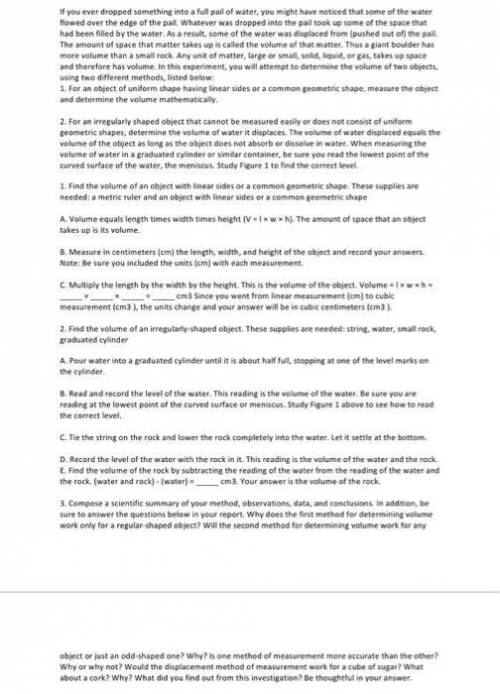
Chemistry, 27.09.2020 09:01 kdcupcake8004
Here are your goals for this lesson: Measure a common geometric shape in centimeters and record answers Calculate volume for the geometric shape Utilize the method of displacement to determine volume Answer questions and summarize results If you ever dropped something into a full pail of water, you might have noticed that some of the water flowed over the edge of the pail. Whatever was dropped into the pail took up some of the space that had been filled by the water. As a result, some of the water was displaced from (pushed out of) the pail. The amount of space that matter takes up is called the volume of that matter. Thus a giant boulder has more volume than a small rock. Any unit of matter, large or small, solid, liquid, or gas, takes up space and therefore has volume. img/groupim2.gifIn this experiment, you will attempt to determine the volume of two objects, using two different methods, listed below: 1. For an object of uniform shape having linear sides or a common geometric shape, measure the object and determine the volume mathematically. 2. For an irregularly shaped object that cannot be measured easily or does not consist of uniform geometric shapes, determine the volume of water it displaces. The volume of water displaced equals the volume of the object as long as the object does not absorb or dissolve in water. When measuring the volume of water in a graduated cylinder or similar container, be sure you read the lowest point of the curved surface of the water, the meniscus. Study Figure 1 to find the correct level. 1. Find the volume of an object with linear sides or a common geometric shape. These supplies are needed: a metric ruler and an object with linear sides or a common geometric shape A. Volume equals length times width times height (V = l × w × h). The amount of space that an object takes up is its volume. B. Measure in centimeters (cm) the length, width, and height of the object and record your answers. Note: Be sure you included the units (cm) with each measurement. C. Multiply the length by the width by the height. This is the volume of the object. Volume = l × w × h = × × = cm3 Since you went from linear measurement (cm) to cubic measurement (cm3 ), the units change and your answer will be in cubic centimeters (cm3 ). 2. Find the volume of an irregularly-shaped object. These supplies are needed: string, water, small rock, graduated cylinder A. Pour water into a graduated cylinder until it is about half full, stopping at one of the level marks on the cylinder. B. Read and record the level of the water. This reading is the volume of the water. Be sure you are reading at the lowest point of the curved surface or meniscus. Study Figure 1 above to see how to read the correct level. C. Tie the string on the rock and lower the rock completely into the water. Let it settle at the bottom. D. Record the level of the water with the rock in it. This reading is the volume of the water and the rock. E. Find the volume of the rock by subtracting the reading of the water from the reading of the water and the rock. (water and rock) - (water) = cm3. Your answer is the volume of the rock. 3. Compose a scientific summary of your method, observations, data, and conclusions. In addition, be sure to answer the questions below in your report. Why does the first method for determining volume work only for a regular-shaped object? Will the second method for determining volume work for any object or just an odd-shaped one? Why? Is one method of measurement more accurate than the other? Why or why not? Would the displacement method of measurement work for a cube of sugar? What about a cork? Why? What did you find out from this investigation? Be thoughtful in your answer.

Answers: 3


Other questions on the subject: Chemistry

Chemistry, 21.06.2019 14:40, 4tazaouiamine1r
What type of solution is formed if 10 g of kclo3 are dissolved in 100g of water at 30
Answers: 2

Chemistry, 21.06.2019 17:00, zaehairston78531
What is the nature of the ca-cl bond in a molecule of calcium chloride (cacl2) if the electronegativity value of calcium is 1.0 and that of chlorine is 3.16?
Answers: 1

Chemistry, 22.06.2019 16:10, nauticatyson9
Given the following equation: 2a1 + 3mgcl2 --> 2alcl3 + 3mg how many moles of aluminum chloride are produced from 2.5 moles of magnesium chloride?
Answers: 1

Chemistry, 22.06.2019 17:30, kaytonleeb
Take a look at this dandelion. the yellow flower on the right is pollinated and the seeds on the left are transported by
Answers: 2
You know the right answer?
Here are your goals for this lesson: Measure a common geometric shape in centimeters and record answ...
Questions in other subjects:


Biology, 01.08.2019 22:30

Mathematics, 01.08.2019 22:30

Mathematics, 01.08.2019 22:30


Health, 01.08.2019 22:30


English, 01.08.2019 22:30

Biology, 01.08.2019 22:30

Mathematics, 01.08.2019 22:30




